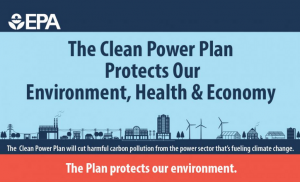The Clean Power Plan is the Transition Needed for the U. S. and the Earth
From a Letter by William D. Ruckelshaus and William K. Reilly, New York Times, September 25, 2016
Last year, President Obama took aim at the nation’s largest source of carbon dioxide pollution, announcing a plan that would reduce these climate-changing emissions from the country’s power plants by one-third by 2030, from 2005 levels.
It is an ambitious proposal to rein in a pollutant that has escaped regulation. But the president was absolutely right in taking this action. As he pointed out, these plants emit more carbon dioxide than our cars, planes and homes combined, and it is this greenhouse gas that is the principal culprit behind the alarming warming of our planet.
Predictably, the plan has run into a determined legal assault from businesses, industry groups and more than two dozen states, many with economies that rely on coal mining or coal-fired electricity generation, and its fate now lies with the judicial branch. On Tuesday, the United States Court of Appeals for the District of Columbia is set to hear a challenge brought by those litigants.
As former administrators of the Environmental Protection Agency who served three Republican presidents, we strongly support the president’s Clean Power Plan. It is consistent with the fundamental, longstanding approach this country has applied in the face of environmental threats. We have filed a supporting brief with the court.
Over the last 45 years, the nation has built a successful, durable legal framework to protect public health and the environment. This is the result of two factors: first, a clear, essential delineation of responsibilities between the federal government and the states; and, second, laws written sufficiently broadly to anticipate new threats to public health. Those critical elements came together in 1970 with the passage of amendments to the landmark Clean Air Act and the creation of the Environmental Protection Agency by President Richard M. Nixon.
The Clean Air Act of 1970 gave the new E.P.A. the duty to set national ambient air-quality standards for six major air pollutants to protect public health. The law also deliberately and explicitly gave states the authority to devise and implement their own plans to meet the E.P.A. standards.
State responsibility was crucial to the legislative compromise that resulted in the amendments’ passage by overwhelming majorities in both houses. Congress recognized that states were closer to the problems they faced, and often had a better understanding of how solutions could be tailored in more cost-effective ways. That consideration has defined virtually all subsequent public health legislation that the E.P.A. administers.
Although states were given the primary responsibility to meet the standards, Congress gave the E.P.A. the power to implement plans of its own if states failed to act. The clear and unmistakable message from Congress to the E.P.A. was to protect the health of Americans.
We have always viewed the E.P.A. first and foremost as a public health agency. In our time running it, both of us faced unanticipated threats to public health. The broad terms of the Clean Air Act gave us authority to act sooner rather than later.
That model — federally set national standards coupled with state planning and implementation — is the bedrock of the legal structure that is now in place to protect public health. The Clean Water Act, Safe Drinking Water Act, Resource Conservation and Recovery Act and Superfund all operate under that framework.
With the Clean Air Act, the success of this approach is clear. Levels of those six major air pollutants regulated by the law — ground-level ozone, particulates, carbon monoxide, nitrogen oxides, sulfur dioxide and lead — have declined substantially, with lead by more than 90 percent, even as the nation’s gross domestic product grew by more than 230 percent.
The current challenge to the E.P.A.’s power-plant rule once again thrusts the role of the states front and center. Principles of states’ rights and responsibilities are at the core of the agency’s approach. The E.P.A. has granted maximum flexibility to states to make the emissions reductions in ways tailored to address their specific circumstances.
Given the explicit deference to state authority embedded in the Clean Air Act, the charge by opponents that this rule amounts to “one of the most aggressive executive branch power grabs,” as one state attorney general put it, simply ignores the law and its success over 45 years.
That law, passed long before climate change had emerged as a looming catastrophe, may not be the ideal tool to address this daunting challenge. But Congress’s failure to take any meaningful action requires the E.P.A. to act with the only tool it has — the Clean Air Act. Once the agency determined that carbon dioxide posed a risk to public health, as it did in 2009, the agency was required to act to reduce that risk, under a 2007 Supreme Court ruling.
The debate about whether the climate is changing is over. The consequences will be drastic if the United States and other countries do nothing. Climate change has no boundaries. It confronts all of us with the reality that what happens anywhere on the planet can affect all of us everywhere.
The actions this country is taking to reduce greenhouse gases exemplify American exceptionalism. Our leadership is indispensable to international progress. Failure to accept and assert that responsibility guarantees that future generations of Americans will face a world markedly different from today’s and bear a cost far in excess of addressing the challenge now.
<<< William D. Ruckelshaus was administrator of the Environmental Protection Agency under Presidents Richard M. Nixon and Ronald Reagan; William K. Reilly was the agency’s administrator under President George H.W. Bush.
See also: www.FrackCheckWV.net

